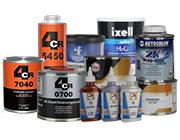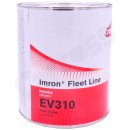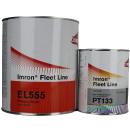Car body paint for your vehicle touch-ups

Car body paint
︾
Everything you need to know about car body paint with Carross
Applying car paint to a bodywork surface requires a methodical approach to ensure an aesthetic, long-lasting and professional result.
Car paint is a central element in the automotive industry, where it not only looks good, but also plays a crucial role in protecting the vehicle from external aggression. Paint has evolved over the years, with different types of paint appearing to meet different needs, whether for touch-ups, repairs or customisation.
There are several types of packaging: Spray, better known as a 400ml can, is often used for Spot-repairs or touch-ups. It can be applied quickly and precisely, making it ideal for small surfaces. On the other hand, the and Degreaser the surface to remove all impurities. Next, it's crucial to mask off any areas that shouldn't be painted, such as windows and mirrors, before applying a primer to allow the new coat of paint to adhere properly. Once the primer has dried, it's time to sand again to achieve a smooth surface.
How do I use a car paint Spray?
Paint is generally applied in several stages, whether it comes in a 400ml spray can, a spray can or a pot. Once the paint has been applied, a protective Clearcoat is added to ensure the paint's durability and resistance to UV rays, weather and scratches. Finally, the bodywork is polished to a brilliant shine or matt finish, depending on the option chosen.
The equipment and materials needed to paint a car
To achieve a professional result, you need the right equipment. A professional spray gun is essential for applying paint and Clearcoat evenly. Putty is used to repair minor imperfections in the bodywork, while abrasive paper is used to sand the surface to a smooth finish. Professionaltools also include protective masks to prevent inhalation of the solvents and VOCs present in some paints.
Advantages and disadvantages:
Each type has its advantages and disadvantages. Solvent-based paints offer high gloss and durability, but have a high environmental impact because of the volatile solvents they contain. Acrylic paints, on the other hand, are easier to apply and more environmentally friendly, although they may be slightly less resistant. Two-component paints, with their mixture of Hardener, guarantee exceptional resistance, but their cost and complexity can be obstacles for certain projects.
Materials required :
2 Primer: To prepare the self-levelling surface.
3 Thinner: If necessary, to adjust viscosity.
4Spray gun : For a professional, uniform result.
5. Air compressor: To power the professional spray gun.
6 Protective tarpaulins or Masking tape: To protect areas not intended to be treated.
Steps for use on bodywork :
1. Prepare the surface:
Make sure the bodywork is clean, dry and free of contaminants. Sand the surface to remove any irregularities and apply a primer to create an adherent base.
2. Protect unpainted areas:
Use protective tarpaulins or Masking tape to cover areas not intended to be painted, such as windows, headlights and tyres.
3. Preparing the mixture :
Follow the manufacturer's instructions to mix correctly.
4. Gun adjustment :
Adjust the compressor air pressure according to the manufacturer's recommendations. Also adjust the flow rate and spray width on the gun.
5. Applying to your car surface :
Apply the first application using even, criss-cross strokes to ensure even coverage. Maintain a constant distance between the gun and the surface.
6. Drying time :
Allow the first application to dry in accordance with the manufacturer's instructions. Drying time may vary according to temperature and humidity.
7. Successive coats :
Apply several Thin layers, leaving a Flash-off between layers. Be sure to follow the manufacturer's recommendations on the number of coats required.
8. Sanding (if necessary):
If imperfections appear, allow your surface to dry completely and sand lightly with fine abrasive paper. Clean the surface before applying a further coat.
9 Finishing :
When all coats are applied and dry, inspect the bodywork to ensure an even finish. Touch-ups may be necessary to correct any imperfections.
10. Final drying time :
Allow your car's surface to dry completely according to the manufacturer's specifications before handling the bodywork or resuming use of the vehicle.
Following these steps will help achieve a professional, long-lasting finish. It is essential to follow the manufacturer's instructions to ensure optimum results.
The different types of car paint:
There are several types of car body paint, each with specific properties adapted to different needs.
Water-based hydro :
Water-based or hydro acrylic, it is environmentally friendly and emits fewer volatile organic compounds (VOCs). It is often used in modern automotive paints.
Solvent-based:
Solvent-based car paints, often called enamels, use organic solvents to dissolve pigments and resins. They are durable and offer excellent weather resistance, but emit more VOCs than water-based car paints.
> Acrylic :
Acrylic paints are water-based and are widely used for touch-up and repair work because they dry quickly and emit fewer VOCs. They are also popular for artistic paints.
> Epoxy :
Epoxy paints use an epoxy resin, making them very durable and resistant to chemicals. They are often used on surfaces exposed to harsh conditions, such as garage floors, but can also be used for car bodywork.
> Polyurethane :
Polyurethane resin-based paints are renowned for their durability and resistance to UV rays. They offer exceptional results and are commonly used in the automotive industry.
> Metallic :
Metallic paint contains fine metal particles that create a shiny, sparkling effect. It is often used to achieve distinctive finishes on cars and motorbikes.
> Pearlescent :
Pearlescent paints contain pearlescent pigments that create an iridescent glow. They are used for special effects and personalised finishes.
Our questions about using car paint :
Here's a compilation of the most frequently asked questions about using full body paint on a car body:
Is it necessary to use a paint primer before painting the bodywork?
Yes, the use of a primer is generally recommended to ensure optimum, long-lasting adhesion of the paint. The primer also creates a uniform surface.
How do I prepare the surface before applying car paint?
Surface preparation involves cleaning, degreasing and sanding to remove imperfections. A primer can also be used to improve adhesion.
Can I use car paint directly on the bodywork without a primer?
Although it is possible, the use of primer is recommended for more durable and professional paint results.
How can I avoid drips when touching up car paint?
A regular technique, avoiding overloading the paint spray gun, helps to minimise the risk of drips. Following the manufacturer's recommendations on dilution can also help.
Should I sand between coats of paint?
Sanding lightly between coats can help achieve a smooth finish. However, follow the manufacturer's instructions, as some paints do not require sanding between coats.
How many coats of car paint should I apply?
The number of coats depends on the type of paint and the manufacturer's specifications. In general, two to three thin layers are recommended for optimum coverage.
How long does it take for the paint to dry completely?
Drying time depends on the type of paint, weather conditions and the number of coats applied. Follow the manufacturer's instructions for the recommended drying time.
Can I use a spray gun or a Spray to apply the car paint?
Both options are possible. Spray guns are often preferred for larger projects, while Spray cans are handy for smaller projects.
How do I care for car paint once it's applied?
Avoid aggressive washing immediately after application. Use mild washing products, keep the vehicle out of the sun and apply a protective Clearcoat if necessary.
How can I avoid bubbles in the paint?
Bubbles can be caused by excessive humidity or by using paint on a hot surface. Make sure the surface is clean and dry, and follow the manufacturer's recommendations.
The different brands of paint available from Carross :
Each brand has its own distinctive features, offering specific formulations and unique benefits. Here is an overview of the main features of some of the renowned brands such as, De Beer, Cromax, Glasurit, Ixell, Lechler, Lesonal, MaxMeyer, Nexa Autocolor, PPG, RM, Sikkens, Spies Hecker and Standox :
De Beer Paint:
De Beer is a brand that offers complete paint solutions. Their paints are often appreciated for their ease of use, durability and remarkable finish.
Cromax Paint:
Cromax, part of the Axalta group, stands out for its high-performance tints. They are renowned for their durability, weather resistance and advanced technology.
Glasurit Paint :
Glasurit, a BASF brand, is known for its top-of-the-range paints. Their products offer exceptional finishes, UV resistance and excellent adhesion.
Ixell Paint :
Ixell offers a diverse range of products. Their portfolio includes professional paints with different finish and colour options.
Lechler Paint:
Lechler is renowned for its innovations in paints. Their products offer a wide range of colours, custom finishes and advanced technological solutions.
Lesonal Paint :
Lesonal, a brand of AkzoNobel, offers high-quality paints. Their products are often characterised by excellent adhesion and durability.
MaxMeyer Paint :
MaxMeyer, part of the PPG group, offers paint solutions. Their paints are known for their reliable performance, ease of use and adaptability to a variety of applications.
Nexa Autocolor paint:
Nexa Autocolor, also part of PPG Industries, offers quality paints with technological innovations. Their products aim to provide high performance finishes and a wide range of colours.
PPG Paint:
PPG is a global company offering a variety of coating products, including paints. Their paints are often characterised by their durability, weather resistance and range of colours.
R-M Paint:
RM, a division of BASF, is known for its high quality paints. Their products often offer exceptional adhesion, UV resistance and a wide range of colours.
Sikkens Paint:
Sikkens, a brand of AkzoNobel, offers top-quality paints. Their products stand out for their durability, exceptional gloss and weather resistance.
Spies Hecker Paint:
Spies Hecker, part of the Axalta group, is renowned for its high-end solutions. Their products are often appreciated for their consistent quality, ease of use and compatibility with different surfaces.
Standox Paint :
Standox, another Axalta Group brand, offers high quality products. Their products are characterised by their durability and wide range of colours.

